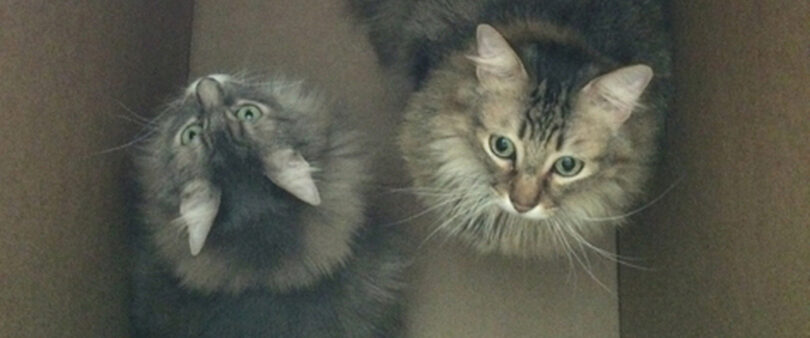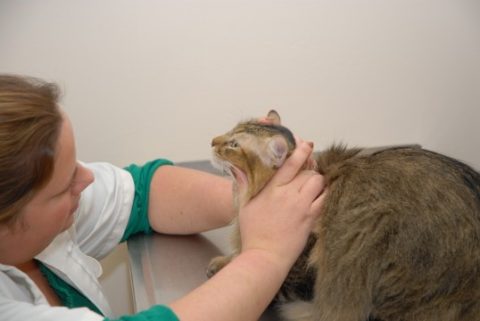Many of us don’t necessarily want to call our vets for every little concern we have about our cats, and some may not be able to afford a vet visit for everything. You might be able to treat small things, like minor feline ear infections, if you notice it early enough. Remember, though, that if your cat’s ears don’t improve, or they get worse, after you try treating them, you do need to take her to the vet.
What causes feline ear infections?
Ear infections are exactly what they say: An infection of the ear canal. Ear mites, allergies, tumors, foreign objects, generalized skin diseases, and trauma, can all cause feline ear infections. Yeast and other fungus can cause infections also.
Whether you decide to try treating it at home, or take your cat to the vet, depends on whether you can figure out what’s causing the infection. Injuries, tumors, and skin diseases all require a vet visit. Ear mites, if you know what they are, may not require a visit, but you will need to get an anti-parasitic from your vet to get rid of the mites.
In case you decide to treat your cat’s infection at home, PetPlace has some advice for you. The first thing to do is to evaluate her ears. Dr. Debra Primovic, of PetPlace, says that if you see bleeding, extreme swelling or redness, or discharge, you should take your cat to the vet. These symptoms mean that the infection is serious enough to need a vet’s intervention.
You might be able to help treat certain feline ear infections with the following steps (but you really need to call your vet):
If the above symptoms of feline ear infections are not present, but you see your cat tilting and shaking her head a lot and you suspect an infection, you can try the following:
- Get a commercial ear cleaning solution, preferably from your vet. You won’t use this first, but you should have it available for when you need it.
- Try cleaning debris out of the parts of your cat’s ears that you can see. You might have to restrain her, so wrap her in a big, fluffy towel, leaving only her head exposed. Use a soft cotton ball or gauze pad dampened with warm water to clean her ear lobes. Rub the pad or cotton ball gently across her ear lobes to remove dirt, wax, and other outer debris. This will help ensure that you don’t introduce more problems into her ear later.
- After you clean her outer ear, start cleaning the cartilage with a cotton swab and warm water. Work to remove any dirt and debris that might be trapped there. Dr. Debra warns, though, that you should always be able to see the tip of the cotton swab. If you try to stick the swab down your cat’s ear canal, you could cause serious problems in addition to making her ear infection worse.
- Once that’s all done, you’ll need to clean out the insides of her ears. To do that, you’ll need the ear cleaning solution you picked up from your vet. Flush a small amount into her ear, and massage the base. Then use a cotton ball to soak up the solution. Be careful, because massaging cats’ ears this way makes them feel funny. She’ll want to shake her head, and she definitely won’t like it.
You’ll also want to give your cat treats periodically throughout this whole process, the way you would when teaching her to tolerate having her nails clipped or dealing with any other unpleasant experience. If she associates a reward with the ordeal, then it’ll be easier to do next time.
It’s best to let a vet treat ear infections, though
Cleaning only works on feline ear infections if foreign debris caused it. If the infection continues after this treatment, then you need to take your cat to the vet. According to Dr. Lorie Hutson, there are often underlying causes that your vet will have to treat to clear the infection. The most common cause of ear infections in cats is ear mites, which you can treat with topical anti-parasitic medications like Revolution. Avoid over-the-counter treatments, because these can have serious side effects for your cat.
If your cat does not have ear mites, and the ear cleaning solution doesn’t help, your vet will look for the underlying cause, and treat that in addition to the infection. Many prescription treatments for ear infections in cats are ointments that you apply manually, and have antibacterial or antifungal properties, depending on what’s causing your cat’s infection.
In the end, though, if your cat is not improving within a day or two of cleaning, you should take her to the vet. Feline ear infections are like other infections in cats, and can become serious if they aren’t treated. Always call your vet if you have questions or concerns.





